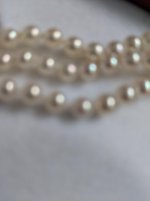mariepearl
Member
- Joined
- Dec 9, 2018
- Messages
- 9
Hello all! I hope everyone's enjoying their Christmas/holiday break if you had one 
My little vintage akoyas (1930s-1940s) have unmatched overtones of green and red on a cream body, but there are a few that seem to reflect an extra color under natural light. It's subtle yet nevertheless visible without having to hold them close up to your eyes, whereas the green/red hues are really only visible to me in photos or close inspection. The green ones tend to reflect a pink light, and the red pearls tend to reflect a blue-aqua light.
It's not like the rainbow iridescence, however, that I see from online photos of some modern akoyas (e.g. Hanadamas). Is there any name for this colored light reflection, or is it merely a continuation of the green/red overtones? Or perhaps the pink/blue reflections are visible because the akoyas are losing layers of the whiter nacre?
It's hard to capture the "extra" colors unless the photo is blurry (hope it doesn't make your eyes hurt - I think it's a bit like an early Gerhard Richter painting). The photos are unedited for color, merely cropped for a closeup and taken inside by a window in natural morning light on an overcast winter day.
Thanks in advance for any thoughts!

My little vintage akoyas (1930s-1940s) have unmatched overtones of green and red on a cream body, but there are a few that seem to reflect an extra color under natural light. It's subtle yet nevertheless visible without having to hold them close up to your eyes, whereas the green/red hues are really only visible to me in photos or close inspection. The green ones tend to reflect a pink light, and the red pearls tend to reflect a blue-aqua light.
It's not like the rainbow iridescence, however, that I see from online photos of some modern akoyas (e.g. Hanadamas). Is there any name for this colored light reflection, or is it merely a continuation of the green/red overtones? Or perhaps the pink/blue reflections are visible because the akoyas are losing layers of the whiter nacre?
It's hard to capture the "extra" colors unless the photo is blurry (hope it doesn't make your eyes hurt - I think it's a bit like an early Gerhard Richter painting). The photos are unedited for color, merely cropped for a closeup and taken inside by a window in natural morning light on an overcast winter day.
Thanks in advance for any thoughts!

